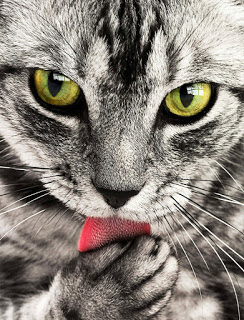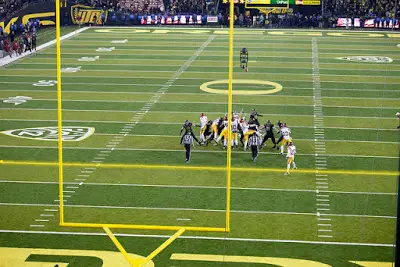 The weekly collection of random and fun facts. In this week’s edition: Do Drugs Pencils, NYC Taxis, Cats Claws, An Odd Sears & Roebuck Purchase, and the Famous Yellow Line of Sports.
The weekly collection of random and fun facts. In this week’s edition: Do Drugs Pencils, NYC Taxis, Cats Claws, An Odd Sears & Roebuck Purchase, and the Famous Yellow Line of Sports.
 This was one moment when somebody wished they had a do-over. In 1998, the Bureau for At-Risk Youth, based in Plainview, New York, had to recall their pencils that said, “Too Cool to Do Drugs”, when an elementary school student discovered that when the pencils were sharpened, they ended up saying, “Cool to Do Drugs”, and then just, “Do Drugs”. The company was a little embarrassed that their slogan ended having an alternate message then what they had intended. They had a new set of pencils manufactured that had the message go in the opposite direction, so when they were sharpened the pencils read, “Too Cool to Do,” then finally, “Too Cool.” Hopefully none of the students took the first messages to heart. Source
This was one moment when somebody wished they had a do-over. In 1998, the Bureau for At-Risk Youth, based in Plainview, New York, had to recall their pencils that said, “Too Cool to Do Drugs”, when an elementary school student discovered that when the pencils were sharpened, they ended up saying, “Cool to Do Drugs”, and then just, “Do Drugs”. The company was a little embarrassed that their slogan ended having an alternate message then what they had intended. They had a new set of pencils manufactured that had the message go in the opposite direction, so when they were sharpened the pencils read, “Too Cool to Do,” then finally, “Too Cool.” Hopefully none of the students took the first messages to heart. Source
 In New York City taxicabs, there is an amber light on the left side of the trunk and at the front of the cab, usually hidden from view behind the grille. When these lights are activated by the driver, they blink to summon the police. According to the NYC rules for distress signal lights that are required on all taxis, the lights must be able to blink 60-120 times per minute, and the driver must be able to reach the button easily and hit it silently. Source
In New York City taxicabs, there is an amber light on the left side of the trunk and at the front of the cab, usually hidden from view behind the grille. When these lights are activated by the driver, they blink to summon the police. According to the NYC rules for distress signal lights that are required on all taxis, the lights must be able to blink 60-120 times per minute, and the driver must be able to reach the button easily and hit it silently. Source
 In most U.S. states, declawing cats is legal, but in most European countries it is illegally unless it is for veterinary medical reasons. Other countries have banned declawing outright if not done for a medical reason, such as Australia, where it has never been common, Israel, Brazil, Slovenia, Japan, and New Zealand. It’s estimated that 20-25% of cats in the U.S. have been declawed. The U.S. Department of Agriculture banned the declawing of wild and exotic animals in 2006. Source
In most U.S. states, declawing cats is legal, but in most European countries it is illegally unless it is for veterinary medical reasons. Other countries have banned declawing outright if not done for a medical reason, such as Australia, where it has never been common, Israel, Brazil, Slovenia, Japan, and New Zealand. It’s estimated that 20-25% of cats in the U.S. have been declawed. The U.S. Department of Agriculture banned the declawing of wild and exotic animals in 2006. Source
 |
| Dustin Moore/Flickr |
In the 1890’s you could buy a small amount of cocaine and a syringe from the Sears & Roebuck catalog for only $1.50. The use of cocaine during this period was used as a cure-all for all sorts of maladies and was even made by a pharmaceutical company; Parke-Davis. Cocaine, along with opiates, were used in a wide range of products and completely unregulated. It wasn’t until the Harrison Narcotics Tax Act of 1914 that these substances were regulated and taxed on their importation, distribution and production. Source
 |
| Ray Terrill/Flickr |
ESPN won an Emmy for the yellow line simulation that represented a first down in football games, the same one that is so common in practically every football game. It was harder to come by then one would think. Stan Honey was the brains behind the yellow line in 1998 and had previously invented the glowing hockey puck that had been used in NHL broadcasts the previous year. No one had been able to come up with a way to insert a yellow line as if it were part of the field during live action, even though the idea had been out there. Sportvision, the company that came up with the technology, proposed the idea to the major networks, but they wanted to think about it. ESPN had a different take and wanted to be the first to introduce the new technology. The NFL approved the yellow line but had some stipulations. The line would have to be thick enough for the viewer to see but not the exact spot of the first down, and the line would have to be able to fade out when the referee put the ball down on the spot, so as not to cause any controversy. The last NFL demand was that it couldn’t be shown in replays.
While the idea and terms had been set out, the actual technology to do it hadn’t been completed. The Sportsvision team had four months to work it out. They made a 3D model of the field and had to find the right color palette so the line would look like it was painted on the field over the green grass. Their team had to go to the stadium three days before a game and map the field, which they would then load into computers. Each camera perspective had to be detected, and they took samples of the grass to match the color palette. All of this was in secret, and they corrected any bugs during preseason games. The first game where everyone felt it was ready was a game between the Baltimore Ravens and Cincinnati Bengals on September 27, 1998. It became a hit. Sportsvision shared the Emmy award with ESPN, and the technology began to be used in every NFL and college game. The NFL even eventually got rid of the requirement that the line fade when the ref spotted the ball since the line had become so accurate. Source
That’s it for another edition. Until next time, and as always, use these facts to annoy those around you with your new found knowledge. Everyone will appreciate you for it
Past Issues of the Completely Random Facts of the Week

